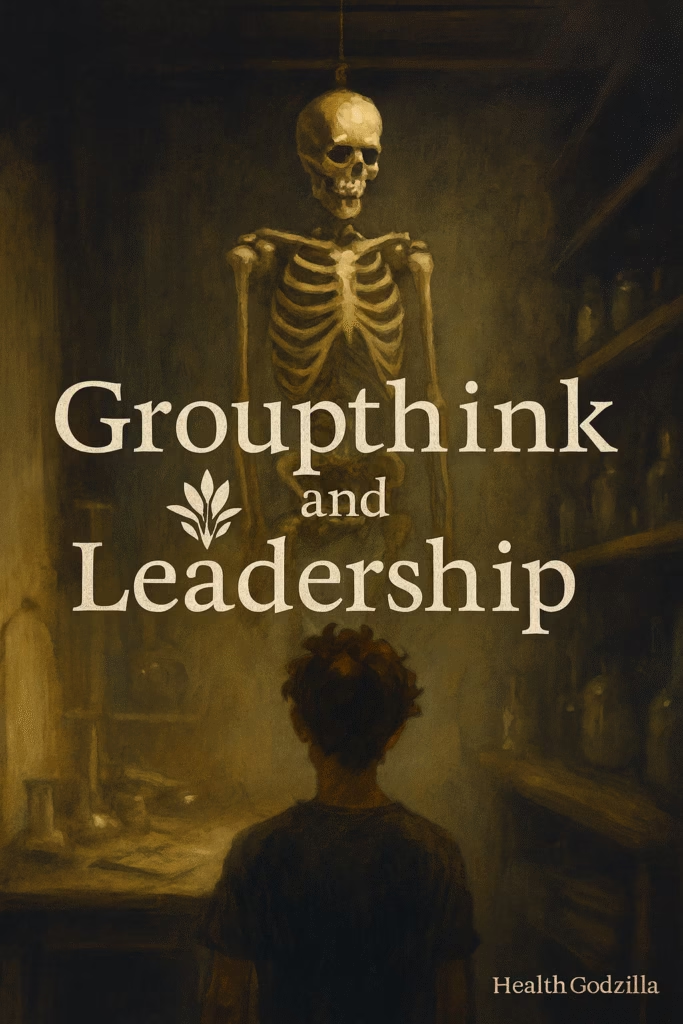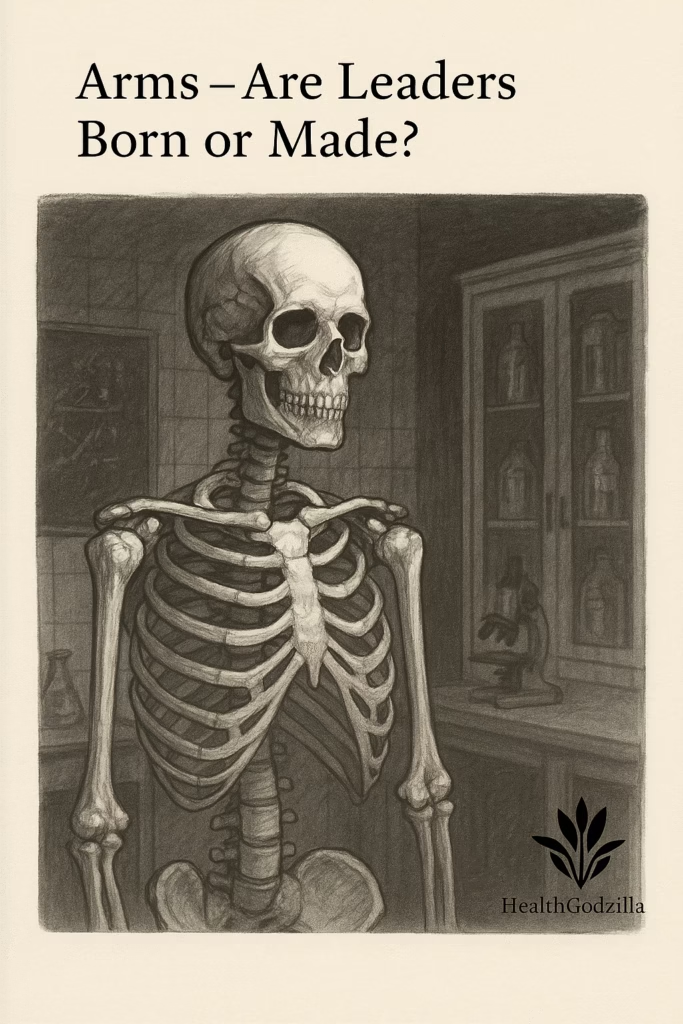
Skull — The Silent Lab of Minds
In a forgotten corner of the university, where the anatomy lab smelled of formalin and solitude, a skeleton hung from the ceiling. Was this not the perfect symbol of groupthink and leadership—rigid, silent, yet waiting to be touched by dissent? Its empty sockets faced the window, where afternoon light filtered in—pale, hesitant, as if afraid to disturb the dead. A junior student stood alone, notebook trembling in hand.
The bones rattled faintly in the breeze, and in that sound one could almost hear the whisper of leaders and groups long gone—Kennedy’s advisers nodding in silence, Enron’s board blinded by brilliance, a young engineer at Hewlett-Packard refusing to obey, and Wood’s experimental groups debating around their imaginary furniture company.
Here, in this eerie silence, the question does not knock politely. It pierces:
What kills a group’s mind—fear of dissent, or worship of genius? And what gives birth to a leader—blood, or the will to grow?
Some say leaders are born, like kings with crowns already pressed to their heads. Others say they are made, carved slowly by mistake, feedback, and defiance. Between these beliefs stretches a battlefield, and in the middle hangs the skeleton—fleshless, voiceless, waiting for someone brave enough to touch it.
This is not a tidy lecture. It is a postmortem. We will peel back the skin of organizations, expose the muscles of group processes, and see where the bones of groupthink and leadership truly lie. If the truth twitches in the cold light—good. Truth should twitch.
And so, with the skeleton as witness, let us begin.
Spine — A Study of Group Processes
When Robert Wood and his colleagues summoned their thirty groups, they did not summon harmony—they summoned a trial by mindset. Half were fixed, half were growth. Each given the same fragile toy of imagination: a furniture company, workers like carved figurines waiting to be placed, moved, motivated.
At first, the skeletons looked the same—skill evenly distributed, vertebrae aligned. But as time passed, the marrow told a different story. The growth-mindset groups fed on error, drank from the chalice of feedback, and their vertebrae lengthened. Their spines flexed, bending but not breaking.
The fixed-mindset groups? Their bones calcified. Fear clamped their jaws, silence crept in like formalin fumes. To speak up was to risk being branded foolish. To dissent was to risk exile. So the spine stiffened into groupthink and leadership, brittle, waiting for a crack.
What was most haunting was not the results on the page, but the rhythm of the voices. In the growth-mindset groups, people spoke—not in unison, but in clash, in debate, in contradiction. Each vertebra jostling with the next until the whole spine found its balance. In the fixed-mindset groups, silence was the marrow.
A study of group processes is not just academic—it is a dissection. The vertebrae tell us: groups are not strong because they agree, but because they disagree without fear. Here lies the raw anatomy of groupthink and leadership—a spine that bends to learn, or stiffens to shatter.
Ribcage — Groupthink versus We-Think
The ribs protect the heart—but they can also cage it. In the 1970s, Irving Janis named the disease: groupthink and leadership entangled in silence. It is when ribs grow too tight, when the heart cannot beat against them. No dissent. No rebellion. Just nods, just silence.
Kennedy’s Bay of Pigs—his advisers, eyes downcast, convinced the Midas-touched president could not err. The invasion was doomed before a single soldier landed, yet no rib cracked open to release a warning.
Enron—the executives who believed their brilliance immunized them against collapse. When asked, “Where are you vulnerable?” they stared blankly. Vulnerability was a language they no longer spoke. Their ribcage had turned to armor, but armor is also a coffin.
And yet, the We-Think ribcage breathes. Alfred Sloan once stopped a meeting at General Motors when everyone agreed too quickly. “Let us postpone until we develop disagreement,” he said—inviting fractures, inviting air. Winston Churchill built a department to deliver him only the worst news, a deliberate crack in his own ribs, so his heart might not suffocate in flattery. Even the Persians of old—drunk, re-deciding their sober choices—knew that truth needed to pass through more than one chamber of the chest.
The lesson rattles in the rib bones:
- A fixed-mindset leader punishes dissent, and the ribs harden.
- A growth-mindset leader rewards defiance, and the ribs expand, lungs fill, breath returns.
The ribcage tells us that a group’s heart beats only when groupthink and leadership are tested by dissent, by cracks that let air in.

Arms — Are Leaders Born or Made?
The skeleton’s arms dangle, one bone pointing backward to ancestry, the other forward to possibility. In the flicker of the lab light, they seem to wrestle with each other—an eternal struggle of nature versus nurture, a struggle at the heart of groupthink and leadership.
One arm whispers: “Leaders are born.” It flexes its biceps of bloodline, charisma, genetic chance. It is the crown placed in the cradle, the natural spark that makes others follow without question. History loves these myths—Caesars, Alexanders, dynasties where leadership is treated like bone structure: inherited, immutable.
The other arm trembles but persists: “Leaders are made.” It grows scar tissue where mistakes cut deep. It swells with feedback, apprenticeships, resilience. Warren Bennis heard this in the voices of the great leaders he interviewed—individuals forged not in wombs but in workshops, in failures, in the long friction of trial and error.
Psychology tells us perhaps thirty percent of leadership emerges from genetics—a hand dealt by chance—but the rest is hammer, chisel, and sweat. Murphy’s “cultures of growth” show us that arms strengthen not by inheritance alone, but by exercise, by reaching for feedback, by daring to dissent.
But beware—the fixed mindset poisons the sinew. It makes a leader arrogant, defensive, brittle. It convinces them their arm was born strong and needs no further strain. The growth mindset, instead, ties sinew with humility, makes the arm supple, able to extend, to pull others up instead of shoving them down.
In the lab, when you tug at the skeleton’s arms, you find no single answer. Born or made? The truth twitches in the ligaments: part fate, part defiance. An arm may be born, but without reaching, without pulling, without touching the world—it withers. And so the arms remind us that groupthink and leadership are never set in stone—they stretch, they strain, they break, and they heal.
Hands — Cultures of Growth
The skeleton’s hands hang open, fingers curled as if in half-memory of a grasp. What they hold determines the fate of every group, every leader, every decision:
- Clenched into fists, they choke dissent, clutching only their own brilliance.
- Open, they cradle innovation, letting fresh voices rest in their palms.
Mary C. Murphy speaks of two cultures that sprout from these hands: the Culture of Genius and the Culture of Growth.
In a Culture of Genius, the hands point, they judge, they measure worth by innate brilliance. To disagree with the genius is to risk exile. Dissent is sandpaper against fragile egos, so it is silenced. These hands grip tight but suffocate.
In a Culture of Growth, the hands beckon. They extend tools, apprenticeships, feedback. They hold open space for mistakes, for risk, for learning. Here, dissent is not poison but oxygen. A young engineer at Hewlett-Packard once defied orders, carried his prototype on the road, and returned with customer love in his palms. Instead of punishment, David Packard pinned a medal on him—for “extraordinary contempt and defiance beyond the normal call of duty.” These are hands that cradle life, not squeeze it out.
Look at your workplace, and you will see which hands it wears. Are they white-knuckled, gripping status and power until the bones creak? Or are they open, scarred perhaps, but generous—ready to catch the sparks of others?
The skeleton’s hands remind us: genius may glitter, but growth plants roots. To build cultures where minds bloom, we must loosen the grasp, unclench the fist, and see that open hands are the true work of groupthink and leadership.
Pelvis — Grow Your Mindset
The pelvis holds the weight of the body, balancing spine and legs. Without it, the skeleton collapses; with it, movement begins. So too with mindset—without practice, without hinge, it is only theory. With practice, it bends into life.
Carol Dweck reminds us: every workplace has its posture. Is it stiff, defensive, bones locked in fear of judgment? Or supple, bending at the hips, ready to learn, to pivot, to carry weight differently?
To grow a mindset is to move at the hinge:
- Less defensive about mistakes. Every fracture teaches bone to knit stronger.
- More open to feedback. Each strike of criticism is a chisel shaping the form.
- Creating learning experiences. Workshops, apprenticeships, coaching sessions—the marrow of practice feeding the bones.
- Leading as collaborator, not boss. To treat colleagues not as extensions of your power but as joints in the same skeleton.
A company itself can be remade at the pelvis. Lou Gerstner once turned IBM’s stiff skeleton into a body that could dance again—not by polishing bones, but by loosening joints, rooting out elitism, and teaching the organization to bow and sway in rhythm.
The pelvis says: don’t just stand. Don’t just hang. Move. Growth is not an abstract prayer—it is the hinge that lets the body step forward, however awkward, however scarred. This is where groupthink and leadership either stiffen into statues or bend into living movement.
Legs — Conclusion: Toward Living Leadership
The legs of the skeleton step not with grace, but with rhythm. Each echo on the tiles reminds us: leadership is not about standing tall and rigid, but about walking—sometimes stumbling, sometimes limping—toward growth.
The first leg is groupthink’s warning. When silence seals the lips, when dissent dies in the throat, the body freezes. A rigid skeleton may look strong, but one kick and it shatters. Fixed-mindset leaders build statues, not movements.
The second leg is the growth of culture and leaders. Not born whole, but made through fractures, through feedback, through the marrow of mistakes. A leader’s walk is not a march down a straight hallway—it is a stagger, a shuffle, a dance. Yet with every awkward step, the muscles of resilience grow stronger.
Together, the legs remind us: to live as leaders, we must keep moving. To trip is not to fail, to stumble is not to end. The danger lies in refusing to step at all, in hanging still as a specimen, embalmed in the comfort of certainty.
So let the skeleton clatter forward. Let the echoes rattle down the lab corridor. Each step is proof that groupthink and leadership are not abstractions but lived rhythms—bone growing only under pressure, motion carving the way toward living leadership.
🍂 Bare Toes — Hello, Artista

The skeleton’s toes scrape the tile, a faint clack like chalk on slate. Into the lab drifts Artista, scarf loose around her shoulders, a trace of Vancouver rain still in her hair. She pauses at the doorway, nose wrinkling at the sharp tang of formalin.
“Organum,” she whispers, “what have you dragged me into this time?”
He grins, Boston vowels curling: “A study in leadership. Or maybe just a dance with bones.” His dogs are not here, but their barks seem to echo in his memory, as if even they sense the macabre classroom.
Artista steps closer to the hanging skeleton. For a moment, fear flashes in her eyes—then curiosity. “So this is what you call groupthink?” she asks. “A ribcage so tight the heart can’t move?”
Organum nods, eyes gleaming. “Yes. And see how the arms argue? One claiming leaders are born, the other insisting they are made.”
Artista tilts her head, listening to the hollow rattle as though it were music. “Strange,” she murmurs. “In this place, bones don’t frighten me. They remind me that growth is not smooth skin, but fractures that heal, scars that shine. Even the rabbits—Whitee and Brownie—nibble through the same wooden bars every night, but still, they grow.”
The skeleton sways gently in the breeze, as though nodding in agreement. Organum chuckles. “Then we are not alone, Artista. We are apprentices in the anatomy of leadership.”
She smiles—soft, steady now. “No one should fear the skeleton, Organum. Only the silence around it.”
And the two of them stand together, toes nearly touching the bones, watching its strange dance as the lab fills with a laughter that is not afraid.
✍️ The Ghost Light — Author’s Reflection
The lab is empty now. The skeleton hangs silent, its brief dance over. Yet the air still trembles with echoes—ribcage ash scattered under the moon, arms tugged by fate and defiance, hands that either choke or cradle, pelvis bending awkwardly into movement, legs thudding against tile as if they might walk out the door.
What was this article? An anatomy lesson? A séance with bones? A parody of philosophy in a medical school lab? I do not know. Perhaps it was only an attempt to look at groupthink and leadership not as tidy diagrams, but as something fleshless and uncanny, something that both frightens and fascinates.
We did not polish. We did not beg for approval. Yet still, we touched the skeleton where it swayed, knowing it might crumble. And yet, in that strange touch, something stirred—call it thought, call it art, call it madness.
Leadership, group processes, the question of born or made—these are not dry case studies. They are marrow, brittle yet alive, waiting for someone to break the bone and taste its truth. Growth is not a straight line, but a shudder. Groupthink is not a definition, but a silence. And writing, too, is not explanation, but haunting.
If this piece feels strange, good. The world itself is strange. To study it honestly is to accept the eerie silhouette, the afterimage that refuses to fade when you close your eyes.
And so the ghost light burns, one candle flickering in the lab of our own making, where skeletons dance, leaders stumble, and dissent rattles like bones in the breeze.
I was not alone when I wrote this. Others spoke, and I listened.
—Jamee
🌼 Articles You May Like
From metal minds to stardust thoughts—more journeys await:
- AOL-Time Warner failure: Merger, mindsets, and market myths. Explore culture clash, transient advantage, primacy, and antitrust risks.
- Biodiversity and nutrition: Reforming diets through agrobiodiversity. Policy, Traditional and Indigenous Foods, and Scientific Relevance.
Curated with stardust by Organum & Artista under a sky full of questions.
📚 Principal Sources
- Dweck, C. S. (2006). Mindset: The new psychology of success. Random House.
- Murphy, M. C. (2023). Cultures of growth: How the new science of mindset can transform individuals, teams, and organizations. Atria/One Signal Publishers.
- Riggio, R. E. (2009, March 24). Leaders: Born or made? Psychology Today.
- Leadership. (n.d.). In Wikipedia. Retrieved September 1, 2025.
Relevant chapters and sections were interpreted through a narrative lens rather than cited academically.
This article is also archived for open access on Zenodo: https://zenodo.org/records/17087994. Archiving ensures its permanence in the scholarly record.

Leave a Reply